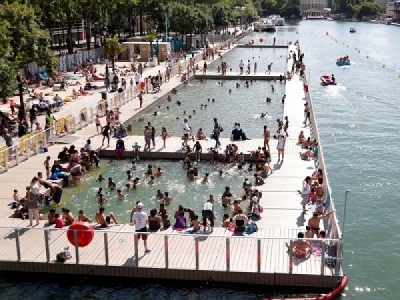
Posted on July 24, 2017
By Feargus O'Sullivan, CityLab
Unlike many cities, the French capital has made good on its promise to re-open urban waterways to bathers. How did they do it?
We’ve all heard promises from cities to make their once-fetid urban waterways swimmable—probably too many. Boston has been pledging to extend the Charles River’s swimmable days for years now, while Berlin’s beautiful plans to turn an arm of the River Spree into a naturally filtered bathing pool remain just that—plans. Baltimore’s proposal to render the oft-garbage-y Inner Harbor swimmable via floating islands of pollution-sucking vegetation and a googly-eyed trash-eating boat are edging ever closer to a 2020 deadline, with limited progress so far, while London’s likeable scheme for a Thames Bath remains the preserve of local enthusiasts rather than actual decision-makers. (Meanwhile, when an environmental activist went for a dip in New York City’s Gowanus Canal in 2015, he had to essentially wear a spacesuit to protect himself from the bacteria-laced toxic soup.)
Among all these maybes, could-bes, and never-attempts, one city stands out for actually making things happen: Paris. For years, the French capital has been promising to open up its urban waterways for safe, clean public swimming. This month, it’s done exactly that.
On Monday, Paris’s Mayor Anne Hidalgo opened-up new open-air swimming enclosure in the Bassin de la Villette, a basin constructed for barges that links the Canal de l’Ourcq with the Canal Saint-Martin in the city’s inner northeast. In temperatures of over 90 degrees Fahrenheit, Parisians lined up to splash about the three new pools fed directly from the canal’s waters, separated from the watercourse’s general flow only by filter meshes to keep leaves and other objects out.
Up to three hundred people at any time can use the lifeguard-protected pools, although the pools only have locker space for 80. Located in a part of Paris already popular as a place to stroll in fine weather, the new bathing spot is likely to prove a major hit in an already hotter-than-average summer. Early reports suggest that the water is indeed delightful, though a small residuum of green algae does make a post-bathe shower a good idea.
How did Paris pull this off? The city’s been working on cleaning up the waters here for decades. Paris’s canals here were once unsurprisingly filthy, running as they do through a former industrial area once packed with cargo barges and polluted by sewage. Since the 1980s, however, regulations managing industrial run-off have tightened substantially, while Paris has invested heavily in wastewater treatment and in preventing sewage from being discharged into the canal during periods of high water. Two years ago, following a concerted clean-up, bacteria levels dropped below safe levels, and rogue bathers have been jumping in the water here for a while. Meanwhile, the Canal Saint Martin, which runs downstream from the basin down to the Seine, was entirely drained and cleaned in 2016, a process that sent a powerful visual message to Parisians that the area’s historic filth was being swept away.
The fact that the water still has a light greenish tinge in its depths didn’t escape some users, such as nine-year-old Laura, who warned Le Monde that “at the bottom of the water it was slimy, there are seaweed, and even small fish nibbling our feet.” Nine points surround the pools to control water quality, ensuring that no one goes into the pools if things get too dirty.
It’s no mean feat to ensure that waters like these running through the heart of a megacity of 12 million people are clean enough to swim in. Paris has declared it won’t stop here: By 2024, it wants the Seine to be swimmable, as well as the Marne, the river that feeds into it via the city’s canals. That’s the kind of promise that many urbanites are used to hearing, of course. But by opening up the Bassin de la Villette to bathers, Paris has, unlike so many other cities, started to put its money where its mouth is.
Source: CityLab





